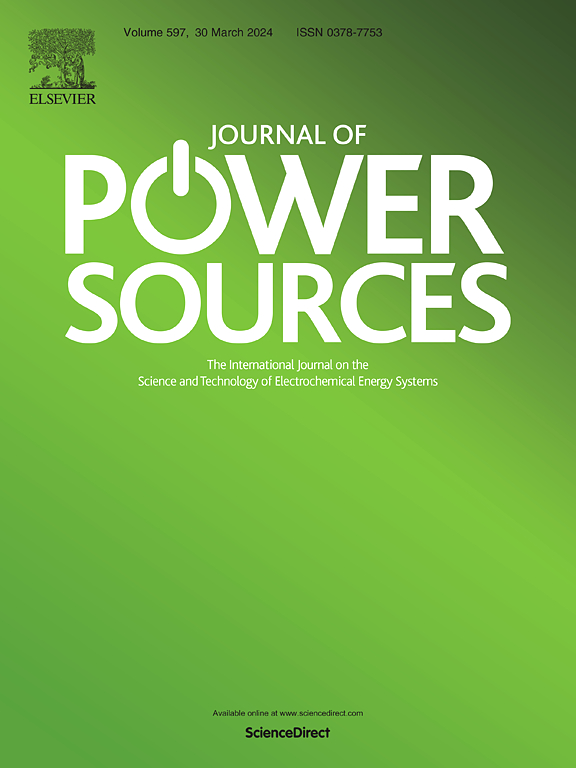Polyethersulfone-based thick polymer-supported graphene sheet for high energy density lithium-ion battery
IF 8.1
2区 工程技术
Q1 CHEMISTRY, PHYSICAL
引用次数: 0
Abstract
High-energy-density graphene-based anodes as lithium-ion batteries have attracted considerable attention for space-constrained applications, including portable devices and electric cars, boosting energy efficiency, performance, and usability. In this work, for the first time, the polyethersulfone sheet (PES-sheet) has been developed by conventional hot-embossing processes and fabricated into a vertically-ionically conductive porous multi-layered and high-energy density free-standing thick graphene sheet using laser-induced graphene (LIG) techniques. Additionally, the hexagonal pores on the PES sheet increase the lithiation and de-lithiation processes without reducing capacity; therefore, the battery lifecycle improves. Scanning electron microscopy(SEM) and optical images investigate the multi-layer-free-standing thick graphene sheet hexagonal-pore, vertically connected and supported by polymer. Also, PES porous LIG formation is studied using Raman spectroscopy and energy dispersive spectroscopy (EDS). The proposed anode as a lithium-ion battery demonstrates capacity retention of 80.70 % from the specific capacity 710 mA h/g at 0.1C and maintains 99 % coulombic efficiency over 200 cycles. Furthermore, the proposed anode as a lithium-ion battery demonstrates a 30 % increase in aerial capacity compared to the commercially available Kapton film. Thus, the multi-layer-free-standing thick graphene LIG anode combined with the simple fabrication techniques and binders-free non-hazardous approach is a promising energy storage candidate for lithium-ion batteries.
用于高能量密度锂离子电池的聚醚砜基厚聚合物支撑石墨烯薄片
基于高能量密度石墨烯的锂离子电池阳极在空间受限的应用领域(包括便携式设备和电动汽车)引起了广泛关注,它可以提高能源效率、性能和可用性。在这项研究中,我们首次采用传统的热压花工艺开发出了聚醚砜片材(PES-sheet),并利用激光诱导石墨烯(LIG)技术将其制成了垂直离子导电的多孔多层高能量密度独立厚石墨烯片材。此外,PES 薄膜上的六角形孔隙在不降低容量的情况下增加了锂化和去锂化过程,从而提高了电池的生命周期。扫描电子显微镜(SEM)和光学图像研究了垂直连接并由聚合物支撑的多层独立厚石墨烯片六角孔。此外,还利用拉曼光谱和能量色散光谱(EDS)研究了 PES 多孔锂离子电池组的形成。所提出的锂离子电池负极在 0.1C 时的比容量为 710 mA h/g,其容量保持率为 80.70%,并在 200 次循环中保持 99% 的库仑效率。此外,与市场上销售的 Kapton 薄膜相比,这种锂离子电池阳极的气动容量提高了 30%。因此,多层无支架厚石墨烯 LIG 阳极与简单的制造技术和无粘合剂的无害方法相结合,是一种很有前途的锂离子电池储能候选材料。
本文章由计算机程序翻译,如有差异,请以英文原文为准。
求助全文
约1分钟内获得全文
求助全文
来源期刊

Journal of Power Sources
工程技术-电化学
CiteScore
16.40
自引率
6.50%
发文量
1249
审稿时长
36 days
期刊介绍:
The Journal of Power Sources is a publication catering to researchers and technologists interested in various aspects of the science, technology, and applications of electrochemical power sources. It covers original research and reviews on primary and secondary batteries, fuel cells, supercapacitors, and photo-electrochemical cells.
Topics considered include the research, development and applications of nanomaterials and novel componentry for these devices. Examples of applications of these electrochemical power sources include:
• Portable electronics
• Electric and Hybrid Electric Vehicles
• Uninterruptible Power Supply (UPS) systems
• Storage of renewable energy
• Satellites and deep space probes
• Boats and ships, drones and aircrafts
• Wearable energy storage systems
 求助内容:
求助内容: 应助结果提醒方式:
应助结果提醒方式:


